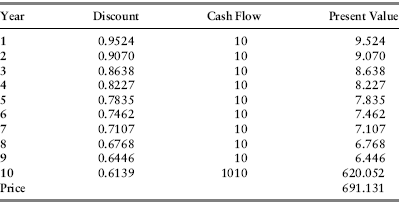Coupon-Bearing Bonds
Think now of a coupon-bearing instrument like a Treasury bond that matures in, say, n years. For example, assume that you are considering a bond that matures in n years with yield r, face value M, and certain (that is, riskless) annual coupon payments equal to C. You want to find the value (the fundamental price) of this stream of cash flows accruing over an n-year period. By lending P, you will receive the stream of cash flows:
 . You wish to value this stream. To do so, you need to discount this stream at a rate that makes the price paid for the bond, P, just equal to the present value of this stream of cash flows. That is, r, which is the bond yield, or yield to maturity, solves
. You wish to value this stream. To do so, you need to discount this stream at a rate that makes the price paid for the bond, P, just equal to the present value of this stream of cash flows. That is, r, which is the bond yield, or yield to maturity, solves

Since this is a constant coupon, then  and so
and so  , or more compactly as
, or more compactly as

Solving for the bond's yield is an iterative procedure that uses some variation of Newton's method. Note:  . Here, the function f is the discounted stream P and the derivative is with respect to r. The par yield solves
. Here, the function f is the discounted stream P and the derivative is with respect to r. The par yield solves  for known
for known  .
.
Example 2.1
Calculate P for a 10-year bond paying annual coupons of $10 with face value equal to $1,000 and yield to maturity of 5 percent. The solution is outlined in
Table 2.1. The present value is the sum of the discounted cash flows and is equal to about $691. Therefore, if our time preferences are consistent with this discount rate and the cash flows are risk free, then this is the fair market value of the bond. Stated differently, if there was a transaction in the bond market for this bond at $691, then someone had preferences that reflected this particular set of discount rates given by

for

.
Table 2.1 Price Calculation for Coupon Bond
A bond has a given price P along with C and M. Therefore r is the yield that equates this cash flow stream to its present value P (just like an internal rate of return).
Now, suppose the coupon is paid semiannually as is the convention. How does this change our thinking? First of all, it means that instead of n cash flows, the holder of the bond will receive 2n coupons plus the face value. Each coupon will be paid after six months, so the semiannual rate of return is one-half of r. Using the 10-year bond example, this translates into the following present valuation scheme:

The first two terms on the right-hand side correspond to the first year's discounted cash flows. So, for a 10-year bond, there are 20 such semiannual flows and a single terminal flow M equal to the face value of the bond.
In all the examples given here, the term r is constant and is referred to as the yield to maturity on the bond. It is the rate that equates the present value of the cash flow stream to its price P. In this way, it behaves like an internal rate of return.
 Go to the companion website for more details.
Go to the companion website for more details.
![]() . You wish to value this stream. To do so, you need to discount this stream at a rate that makes the price paid for the bond, P, just equal to the present value of this stream of cash flows. That is, r, which is the bond yield, or yield to maturity, solves
. You wish to value this stream. To do so, you need to discount this stream at a rate that makes the price paid for the bond, P, just equal to the present value of this stream of cash flows. That is, r, which is the bond yield, or yield to maturity, solves![]()
![]() and so
and so ![]() , or more compactly as
, or more compactly as ![]()
![]() . Here, the function f is the discounted stream P and the derivative is with respect to r. The par yield solves
. Here, the function f is the discounted stream P and the derivative is with respect to r. The par yield solves ![]() for known
for known ![]() .
.

![]() Go to the companion website for more details.
Go to the companion website for more details.